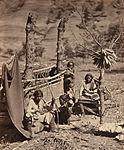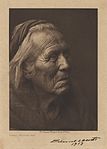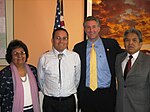Navajo


Navajo (navajo: Diné) är det indianfolk som har det största antalet ättlingar i dagens USA. Deras antal uppgår till 250 000.[1] Navajo har sin geografiska hemvist i sydvästra USA, framför allt i de intill varandra gränsande områdena i delstaterna Arizona, New Mexico, Utah och Colorado.[1] De flesta bor i Navajoreservatet, som är det största indianreservatet i USA.[1]
Historia
Under en 300-årsperiod bekämpade stammen envist men utan framgång såväl spanska som andra kolonisatörer.[källa behövs] Navajofolket förde en seminomadisk tillvaro; troligtvis påverkade genom de bofasta puebloindianer som tidigare bebott stammens kärnområde.[källa behövs]
Idag
Även idag lever många av dem som herdar med små hjordar med får och getter.[1] Vissa medlemmar av navajofolket försörjer sig genom att sälja smycken av silver och turkos till förbipasserande turister.[1][2]
Bildgalleri
- Navajofamilj. Fort Defiance, Arizona, 1873.
- Medicinman. Foto Edward S. Curtis, 1913.
- "Tom Torlino, Navajo, before and after." Foto J. N. Choate ca 1882.
- En kongressledamot träffar represantanter för the Navajo Nation Council on Education, 2006.
Referenser
- ^ [a b c d e] ”Navajo Indians Today” (på engelska). Peoples of Mesa Verde. Crow Canyon Archaeological Center. https://www.crowcanyon.org/EducationProducts/peoples_mesa_verde/today_navajo.asp. Läst 31 juli 2017.
- ^ ”Navajo Jewelry” (på engelska). Navajo People. 2011. Arkiverad från originalet den 7 augusti 2017. https://web.archive.org/web/20170807110154/http://navajopeople.org/navajo-jewelry.htm. Läst 31 juli 2017.
Externa länkar
 Wikimedia Commons har media som rör Navajo.
Wikimedia Commons har media som rör Navajo.
Media som används på denna webbplats
Författare/Upphovsman: User:ish ishwar, Licens: CC BY-SA 3.0
Apachean tribes ca. 18th century
Abbreviations:
- WA (red map region) - Western Apache (Apacheeg ar c'hornôg) Tonto, Coyotero;
- N (orange map region) - Navajo;
- Ch (blue map region) - Chiricahua, Ndendahe, Mimbreño;
- M (green map region) - Mescalero;
- J (purple map region) - Jicarilla;
- L (yellow map region) - Lipan (Lipek);
- Pl (brown map region) - Plains Apache (Kataka c.d. "Kiowa Apache", Apacheeg ar c'hompezennoù).
"Tom Torlino, Navajo, before and after." Black and white photographic portrait of a Navajo by J. N. Choate. Image courtesy of the Richard Henry Pratt Papers, Beinecke Rare Book & Manuscript Library.[1]
The "before" photo was taken in 1882, when Tom Torlino arrived at Carlisle Indian Industrial School. John Choate snapped the photo in his Carlisle studio. The "after" photo was taken three years later, in 1885. Historians Barbara Landis and Richard Tritt believe Choate manipulated the lighting in the second photo to help make a point: with the proper education, Carlisle students could literally blend in with white society.
Tom Torlino entered Carlisle School on October 21, 1882 at the age of 22 and departed on August 28, 1886. By 1910, he was living in Tohatchi, New Mexico.
Vintage albumen print. Original caption "Aboriginal life among the Navajoe Indians. Near old Fort Defiance, N.M. / T. H."
Författare/Upphovsman: Ish ishwar (diskussion · bidrag), Licens: CC BY-SA 3.0
The present-day primary locations of Apachean peoples (including reservations and cities)
- Note that here Navajo is included as Apachean.
- Other Apachean peoples are dispersed throughout the continent. In particular, there are Lipan in Texas and a large number of Navajos in New York City.
- Color indicates association:
* Red map regions - Western Apache (Apacheeg ar c'hornôg) Tonto, Coyotero * Orange map regions - Navajo * Blue map regions - Chiricahua, Ndendahe, Mimbreño * Green map regions - Mescalero * Purple map regions - Jicarilla * Yellow map regions - Lipan (Lipek)* Brown map regions - Plains Apache (Kataka c.d. "Kiowa Apache", Apacheeg ar c'hompezennoù)
5 X 7 inch (image size) photogravure of a Navaho medicine-man ©1904 on composition board, with original signature of Edward S. Curtis and 1913 date - photo cropped from 8.5 X 11 inch original sheet, but otherwise not modified or retouched
Congressman Rick Renzi meets with the Chairman of the Navajo Nation Council on Education Leonard Chee and other Navajo Nation education officials. From left to right - Mary Helen Creamer, project manager Dine Education Center, Leonard Chee - Chairman, Navajo Nation Council on Education, and Leland Leonard - executive director Dine Education Center.









